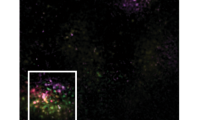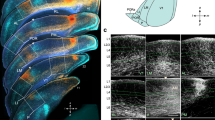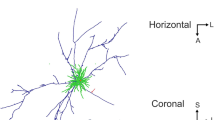Abstract
In primates, both the primary and secondary visual cortical areas can be subdivided histologically by staining for the mitochondrial enzyme cytochrome oxidase1–3. In the primary visual cortex (area 17, the first cortical receiving area for visual information) these histological differences correspond to functional subdivisions1–6, cytochrome-dark regions being concerned with information about colour and cytochrome-light regions concerned with form. Here we report that the second visual area, area 18, which receives its main cortical input from area 17 (refs 7,8), similarly has functional subdivisions that correspond to the cytochrome oxidase staining pattern. In area 18 the segregation between form and colour is maintained, reinforcing our notion that form and colour information follow parallel pathways. The specific differences between cells in areas 17 and 18 suggest that a possible step in hierarchical information processing is spatial generalization, analogous to the difference between simple and complex cells.
This is a preview of subscription content, access via your institution
Access options
Subscribe to this journal
Receive 51 print issues and online access
$199.00 per year
only $3.90 per issue
Buy this article
- Purchase on Springer Link
- Instant access to full article PDF
Prices may be subject to local taxes which are calculated during checkout
Similar content being viewed by others
References
Hendrickson, A. E., Hunt, S. P. & Wu, J.-Y. Nature 292, 605–607 (1981).
Horton, J. C. & Hubel, D. H. Nature 292, 762–764 (1981).
Tootell, R. B. H. & Silverman, M. S. Soc. Neurosci. Abstr. 7, 356 (1981).
Livingstone, M. S. & Hubel, D. H. Proc. natn. Acad. Sci U.S.A. 79, 6098–6101 (1982).
Tootell, R. B. H., Silverman, M. S., DeValois, R. L. & Jacobs, G. H. Science 220, 737–739 (1983).
Livingstone, M. S. & Hubel, D. H. J. Neurosci. 4, 309–356 (1984).
Kuypers, H. G. J. M., Szwarcbart, M. K., Mishkin, M. & Rosvold, H. E. Expl Neurol. 11, 245–262 (1965).
Myers, R. E. Ciba Fdn Symp. 20, 133–143 (1965).
Baizer, J. S., Robinson, D. L. & Dow, B. M. J. Neurophysiol. 40, 1024–1037 (1977).
Hubel, D. H. & Wiesel, T. N. J. Physiol. Lond. 160, 106–154 (1962).
Hubel, D. H. & Wiesel, T. N. J. Neurophysiol. 28, 229–289 (1965).
Allman, J. M. & Kaas, J. H. Brain Res. 35, 89–106 (1971).
Dubner, R. & Zeki, S. M. Brain Res. 35, 528–532 (1971).
Zeki, S. M. Brain Res. 53, 422–427 (1973).
DeYoe, E. A. & Van Essen, D. C. Soc. Neurosci. Abstr. 10, 934 (1984).
Shipp, S. & Zeki, S. Nature 315, 322–325 (1985).
Verry, D. Archs Ophthalmol., Paris 8, 289–300 (1888).
MacKay, G. & Dunlop, J. C. Scott. med. surg. J. 5, 503–512 (1899).
Critchley, M. Brain 88, 711–724 (1965).
Pearlman, A. L., Birch, J. & Meadows, J. C. Ann. Neurol. l5, 253–261 (1979).
Damasio, A., Yamada, T., Damasio, H., Corbett, J. & McKee, J. Neurology 30, 1064–1071 (1980).
Wong-Riley, M. T. T. Brain Res. 171, 11–28 (1979).
Author information
Authors and Affiliations
Rights and permissions
About this article
Cite this article
Hubel, D., Livingstone, M. Complex–unoriented cells in a subregion of primate area 18. Nature 315, 325–327 (1985). https://doi.org/10.1038/315325a0
Received:
Accepted:
Issue Date:
DOI: https://doi.org/10.1038/315325a0
This article is cited by
-
Function-specific projections from V2 to V4 in macaques
Brain Structure and Function (2022)
-
Cross-orientation suppression in visual area V2
Nature Communications (2017)
-
Getting there and being there in the cerebral cortex
Experientia (1995)
Comments
By submitting a comment you agree to abide by our Terms and Community Guidelines. If you find something abusive or that does not comply with our terms or guidelines please flag it as inappropriate.



